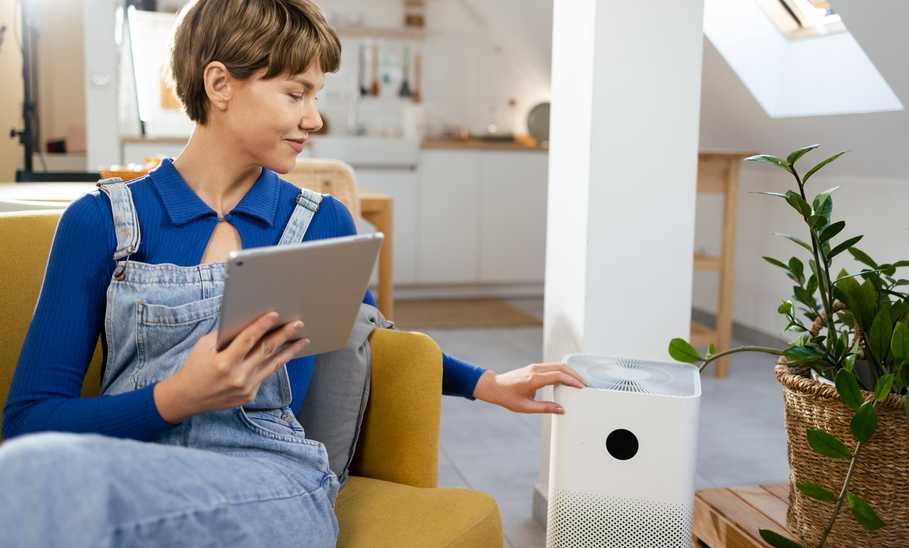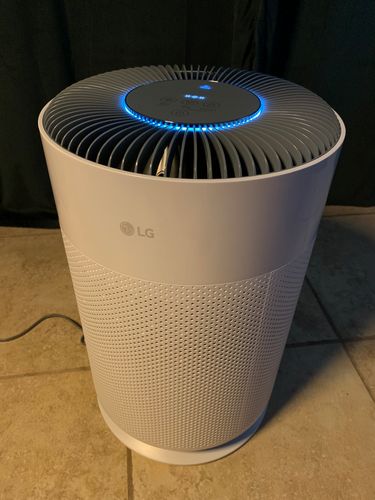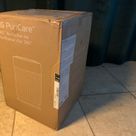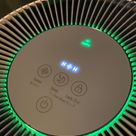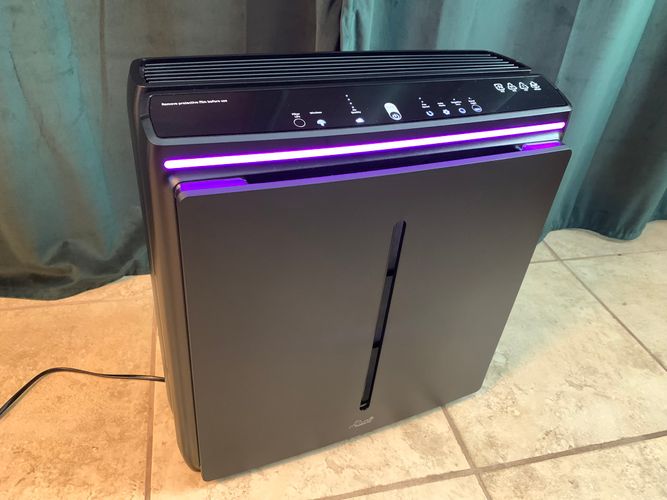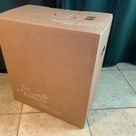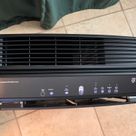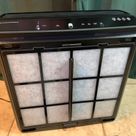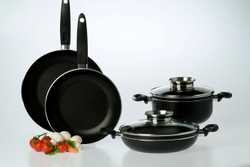Everyone knows allergy season is a terrible time for your nose, throat, and lungs. But even the tidiest home owners may not realize the amount of eye-watering mold spores, pollen, dust, and other pollutants floating around and entering your lungs every day. An air purifier is a simple solution for straining out unseen pet dander, mildew, and other nasty particulates for noticeably easier indoor breathing, but with so many brands, sizes, and models available, it can be difficult to even begin searching for the best one for your unique space and filtration needs.
After a considerable amount of research and testing, I have pristine air quality in my product testing lab, and a list of this year’s most efficient and effective air purifiers. Here’s how to select the best air purifier for your home.
Our top picks for best air purifiers
Best smart air purifier: Mila

Mila
While an air purifier with smart device functionality isn’t too special on its own, the Mila stands out by offering customizable air speed levels, as opposed to basic low, medium, and high modes. The Mila is the most customizable air purifier because of its range of specialty filters for pet owners, allergen sufferers, and top-of-the-line filters for trapping every ultrafine particle in the room. I’m also a fan of Mila’s chic design, quiet operation, how easily its companion app displays the current air quality around the unit, and overall value for your purchase.
Specifications
- CADR rating: 245-447 CFM, depending on the filter you buy
- Noise level: 24 decibels
- Dimensions: 12 x 12 x 15 inches
- VOC filtration: Yes, 75.56 -97.89%, depending on the filter you buy
- Weight: 7.3 pounds
- Room size: 700 square feet
- Price on publish: $419.99
Pros:
- Customizable air purifier speeds
- User-friendly app
- Seven long-lasting filters to choose from
Cons:
- “Smart,” but doesn’t integrate with smart home platforms
The bottom line:
Perfect for freshening up small to mid-sized spaces, a Mila air purifier offers customizable air cleaning speeds and special filter types.

GoveeLife Smart Air Purifier Lite
Govee proves you don’t have to spend hundreds of dollars for a solid air purifier, as their Smart Air Purifier Lite is well-suited for pulling offending odors, pollen, dust, and other nasty airborne particles from the air for just $50. You may be surprised to find an air purifier with a HEPA filter, voice controls via Alexa, Google, Apple, and other smart home platforms, but this inexpensive model is the best solution for pet owners, quickly deodorizing rooms, and removing airborne household allergies on a budget.
Specifications
- CADR rating: N/A
- Noise level: As low as 24 decibels
- Dimensions: 6.2 x 10.7 x 6.2 inches
- VOC filtration: Yes
- Weight: 2.5 pounds
- Room size: 376 square feet
- Price on publish: $49.99
Pros:
- Affordable
- Smart home voice controls
- Runs quietly
Cons:
- Govee’s only air purifier is best suited for smaller rooms
The bottom line:
This small, reliable, and notably inexpensive Govee air purifier makes it an inexpensive snap to remove pet dander, pollen, smoke, and other airborne pollutants.

Blueair Blue Pure 411a Max
If you’re looking for an air purifier that pulls dust, pet dander, mold, smoke, and other nasty impurities from your bedroom, but don’t want the associated noise, Blueair’s 411a Max’s whisper-quiet operation is your best bet. This fairly priced model runs as low as a mere 18 decibels — literally quieter than the average whisper. I appreciate how quickly it cleans a room, and how the 411a Max is available in four attractive colors.
Specifications
- CADR rating: 141 CFM
- Noise level: 46 decibels
- Dimensions: 10.6 x 10.6 x 18.9 inches
- VOC filtration: No
- Weight: 7.4 pounds
- Room size: 526 square feet
- Price on publish: $139.99
Pros:
- Extremely quiet operation
- Speedy and effective air cleaner
- Top-mounted LED air quality indicator
The bottom line:
Many air purifiers advertise themselves as near-silent, but at its quietest, Blueair’s Blue Pure 411a Max is approximately twice as loud as the sound of a person breathing — as close to silent as they come.

PureZone Mini Portable Air Purifier
No matter how hard you try to keep your car pristine, you bring more pollen, dust, and other air pollutants inside every time you get in the driver seat. This tiny travel-sized air purifier freshens up your ride and comes in five slick color options. I like how this lightweight model easily fits in a cup holder, and how quickly it cleans the air around you. The Mini Portable is the easiest way to clean the air in your car, truck, or van, and it’s surprisingly effective at getting musty odors out of small closets, as well.
Specifications
- CADR rating: 4 CFM
- Noise level: 35-43 decibels
- Dimensions: 8.5 x 3.3 x 2.7 inches
- VOC filtration: No
- Weight: 0.58 pounds
- Room size: Six square feet
- Price on publish: $44.99
Pros:
- Affordable
- Small, featherweight design
- Works quickly
Cons:
- Don’t bother trying to clean anything in your home bigger than a tiny closet
The bottom line:
If you spend considerable time in your car, it’s worth investing in the Mini Portable for distinctly cleaner air.
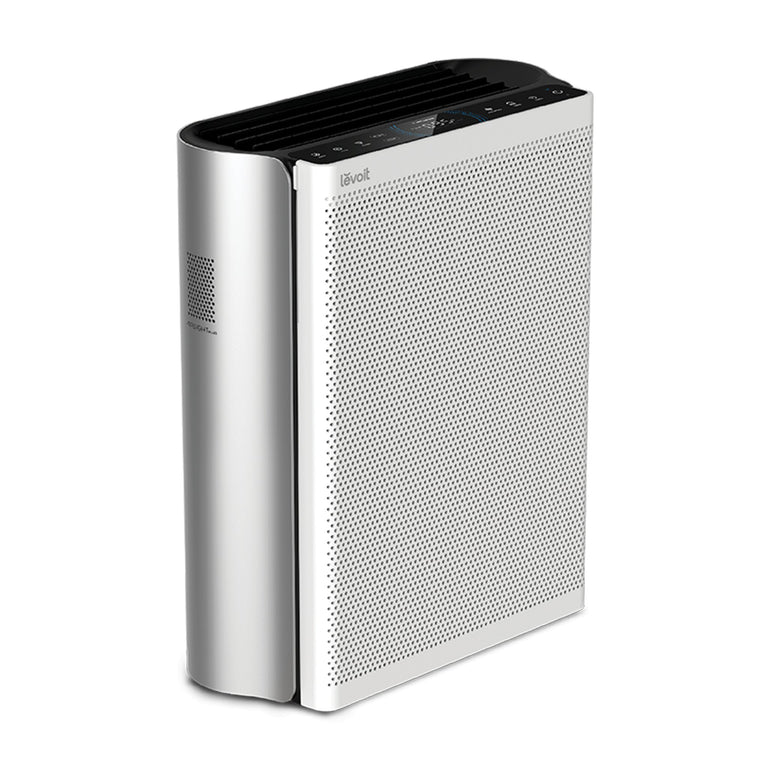
Levoit EverestAir Smart Air Purifier
Plenty of air purifiers made for extra-large living spaces, but the EverestAir is my top pick for how impressively fast it removes pet dander, cooking odors, and dust. This model’s ability to thoroughly clean spaces up to 558 square feet within 12 minutes will grab your attention, while the ability to schedule cleanings via its companion app, voice controls, and quiet operation will keep it. I was impressed that the EverlastAir uses its laser-based airborne particulate scanner to automatically crank up its fan if the air quality worsens, and switches to a lower power setting immediately afterward.
Specifications
- CADR rating: 360 CFM
- Noise level: 24-56 decibels
- Dimensions: 18.9 x 8.5 x 23.2 inches
- VOC filtration: Yes
- Weight: 20.7 pounds
- Room size: 558 square feet
- Price on publish: $499.99
Pros:
- Surprisingly fast cleaning
- Packed with useful features
- Highly adjustable air vents direct clean air where you want it most
Cons:
- At over 20 pounds, it’s fairly hefty
The bottom line:
Although the EverestAir works well in all room sizes, this heavy-duty air purifier swiftly circulates and deep-cleans extra-large areas faster than you might expect.

Honeywell Allergen Plus True HEPA Tower Air Purifier
Since you spend plenty of time in your home office, it’s worth buying a smaller air purifier to eliminate dust, pollen, and animal dander from your air. This affordable desktop Honeywell model is a top office pick because it’s effective when it comes to trapping nasty particles and odors with its HEPA filter. It boasts an energy-efficient design that uses less power than the average air purifier.
Specifications
- CADR rating: 48 CFM (tobacco smoke), 62 CFM (dust), 75 CFM (pollen)
- Noise level: Reliably quiet
- Dimensions: 10.69 x 7.72 x 15.16 inches
- VOC filtration: Yes
- Weight: 6.39 pounds
- Room size: 75 square feet
- Price on publish: $99.99
Pros:
- Optimized for small spaces
- Uses minimal electricity
- Excels at capturing airborne allergens
- ENERGY STAR certified
Cons:
- Not the quietest air purifier, but it’s far from noisy or distracting
The bottom line:
This inexpensive Honeywell air purifier sports a minimalist design and quickly removes airborne allergens from smaller rooms, making it a perfect fit for your office space.
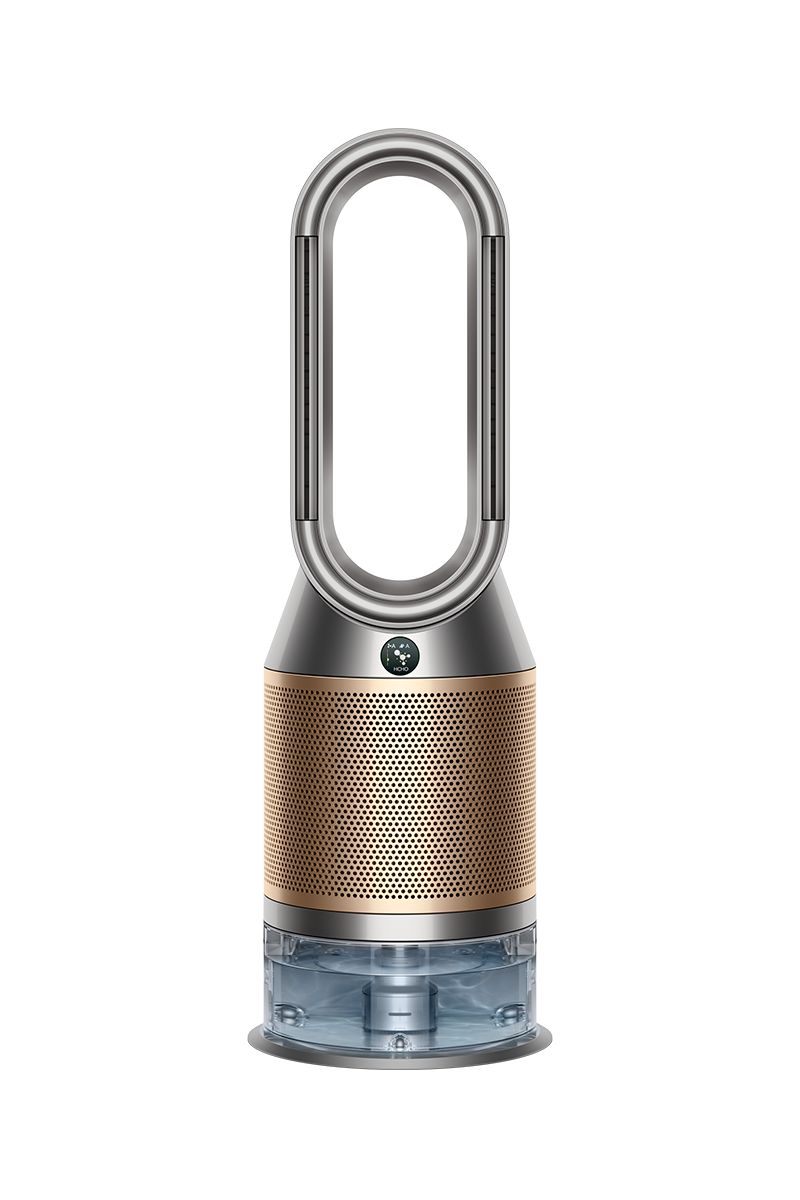
Dyson Purifier Humidify+Cool Formaldehyde PH04 (Nickel/Gold)
15% offSave $150
Dyson may be best known for its impressive vacuum cleaners, but their Humidify+Cool Formaldehyde pulls triple duty as an air purifier, humidifier, and cooling fan, making it an excellent model for year-round comfort. It features the premium air-cleaning you’d expect from Dyson’s top-tier HEPA filtration, especially when it comes to its namesake ability to trap extremely tiny formaldehyde particles released from your home while converting them into water. Speaking of water, its humidifier kills bacteria in its one-gallon tank, which lasts up to 36 hours before needing a refill. Other highlights include its cooling fan for the hot months, convenient voice controls, and how easy it is to check the room’s air quality at a glance via its large color LCD display.
Specifications
- CADR rating: N/A
- Noise level: 49 decibels
- Dimensions: 36.33 x 12.28 x 11.02 inches
- VOC filtration: Yes
- Weight: 18 pounds
- Room size: 400 square feet
- Price on publish: $999.99
Pros:
- High-end air purifier traps extremely tiny particles like formaldehyde
- Bacteria-killing humidifier with extra-large tank
- Not quite an air conditioner, but an awesome alternative
The bottom line:
Dyson’s Humidify+Cool Formaldehyde may be pricey, but it delivers air cleanliness and room-cooling convenience you won’t get from other air purifier-humidifier combination devices.

Clorox Smart Large Room Air Purifier
If you expect an air purifier made by Clorox to effectively remove mold spores and other nasty pollutants from your air, you’re absolutely right. If you need an air purifier to strain out larger particulates from the room such as mold and mildew, pet dander, dust, and even bacteria and viruses while eliminating offending odors, I recommend this model. Sure, it doesn’t have voice controls or feature a companion smartphone app. But it’s surprisingly affordable, easily snaps up mold spores, and its filters can last up to a year before needing to be replaced.
Specifications
- CADR rating: 206 CFM (smoke), 219 CFM (dust), 232 CFM (pollen)
- Noise level: Up to 44 decibels
- Dimensions: 10 x 10 x 19 inches
- VOC filtration: Yes
- Weight: 7.34 pounds
- Room size: 320 square feet
- Price on publish: $169.99
Pros:
- Affordable
- Easily contains mold, mildew, and many other particulates
- Long-lasting filters
The bottom line:
Clorox’s best air purifier offers few impressive extras, but it’s an inexpensive and dependable mold and mildew-trapping machine.
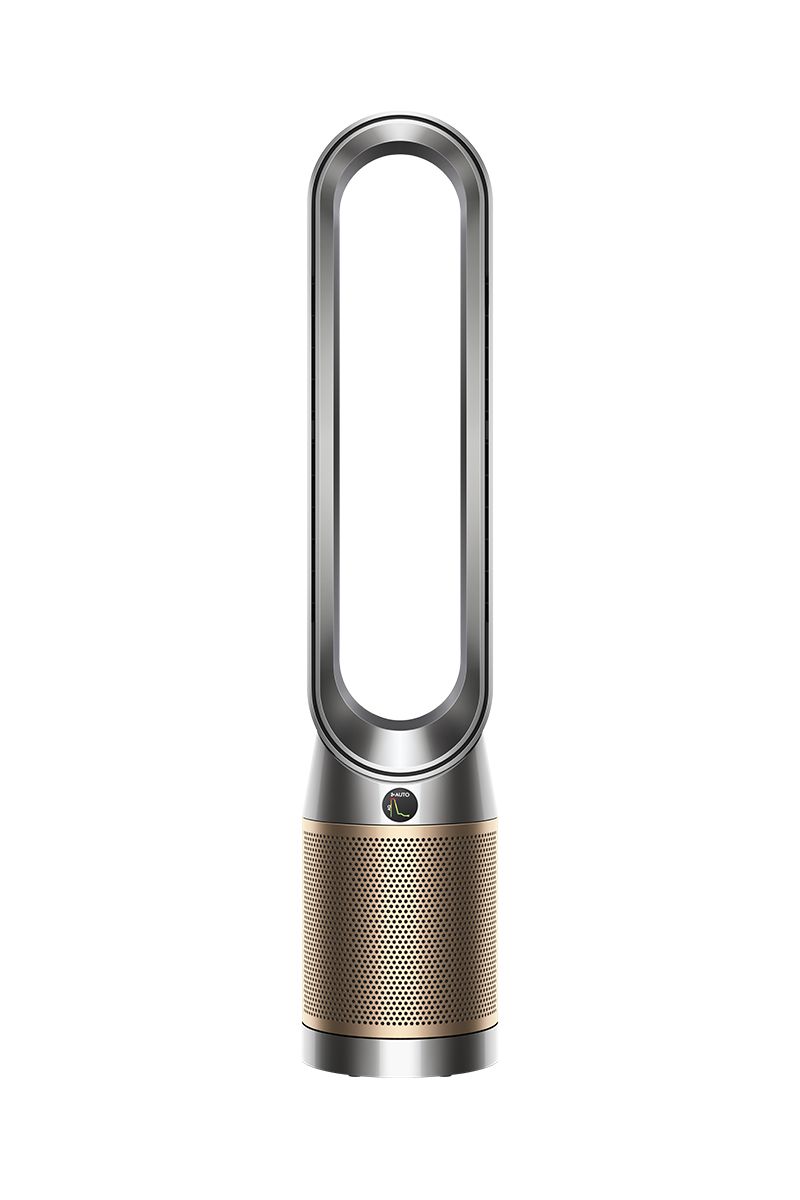
Dyson Purifier Cool Formaldehyde TP09 (Nickel/Gold)
The Dyson Purifier Cool Formaldehyde’s ability to trap 99.97% of allergens from the air via its HEPA filter, how easily it purifies larger rooms with its powerful circulating fan, and its crisp LCD display that notes the area’s air quality at a glance, make it an allergy sufferer’s best option for breathing easy indoors. The Dyson Purifier Cool is a high-end air purifier for ridding your whole home of airborne allergens like dust, pollen, and dander, its cooling fan is good for warm climates, and it helps eliminate formaldehyde gas your home gives off. If you’re concerned about a fan-based model, it also features a convenient backward-flow mode to purify the room without cooling it.
Specifications
- CADR rating: N/A
- Noise level: N/A, but a bit noisier than the average air purifier
- Dimensions: 41 x 4.72 x 8.7 inches
- VOC filtration: Yes
- Weight: 10.7 pounds
- Room size: 999 square feet
- Price on publish: $749.99
Pros:
- Premium filtration system
- Powerful cooling fan
- Voice and smartphone controls
Cons:
- Expensive, but you get your money’s worth
The bottom line:
This value-packed air purifier traps commonplace household allergens, and its fan helps quickly clean spaces while cooling your home.
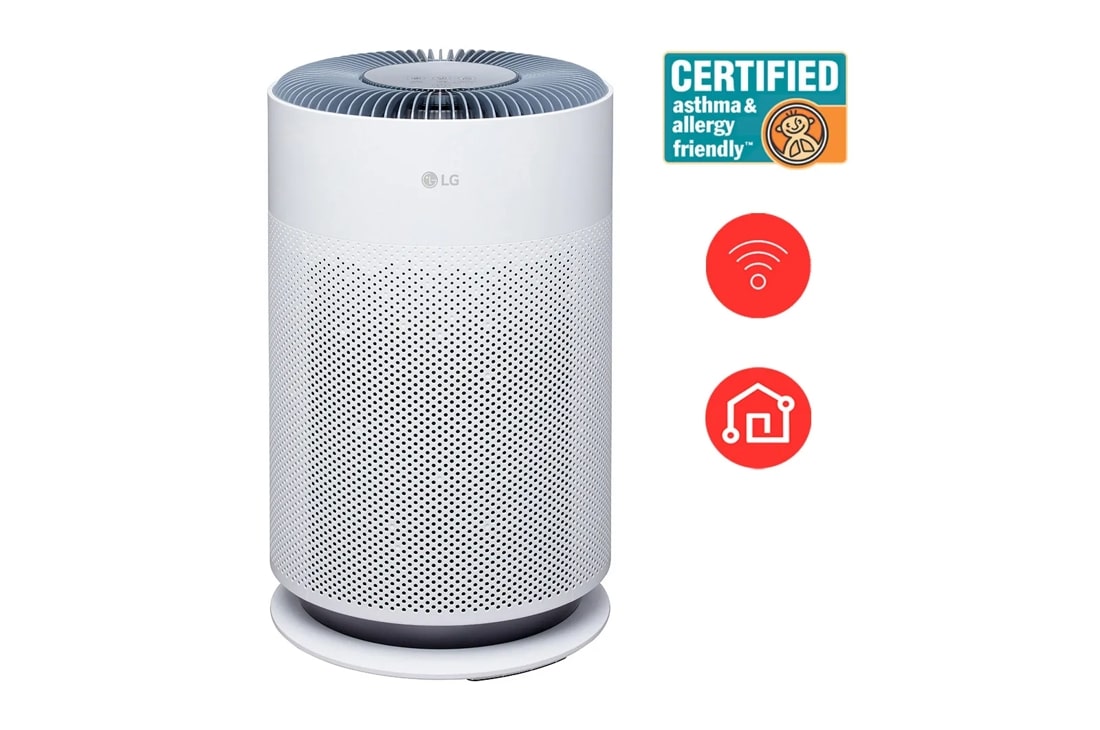
LG PuriCare™ 360 with NanoFiber True HEPA, White
33% offSave $100
While there are many air purifiers that do a great job of removing pollutants from the air, people with severe allergies and asthma need a superior model that will live up to the lofty claims of its manufacturer. Thankfully the Asthma and Allergy Foundation of America (AAFA) puts air purifiers through rigorous testing and if a device meets or exceeds their high standards, it receives an asthma and allergy friendly certification. The good news is that LG’s charming AAFA Certified PuriCare 360 retails for $300 (or less, if on sale). This relatively lightweight air purifier is an all-around impressive pick because of how quickly and efficiently its NanoFiber True HEPA filter clears ultrafine particulates from spaces up to 2,500 square feet. You can expect it to remove VOCs (chemicals emitted by your home), mold, viruses, bacteria, and toxic ultrafine particulate matter produced by gas powered vehicles.
I appreciate the LG PuriCare 360’s many conveniences. It’s a snap to bring from room to room to purify the entire house, its bright LED ring signifies air quality at a glance, and its comprehensive smartphone app details how many particles of various sizes are being collected by the unit throughout the day. This model proved its worth during testing when my home smelled smoky one evening because a neighbor was burning yard waste. Although it turned on with a cautionary yellow LED ring, within 15 minutes the PuriCare 360 completely wiped out the burning odor from my house and reverted to its green “excellent air quality” indicator.
Other high points include its whisper quiet low mode, how easy it is to swap out air filters when needed, and a compact barrel shape that takes up very little floor space. Between its relatively low price for what you get, just how efficient and fast it is at pulling even the tiniest harmful particulate from your space, it’s easily the most cost-effective option for dependably clean indoor air.
Dr. John McKeon, CEO of Allergy Standards Limited, highly recommends this air purifier as well. “LG’s PuriCare 360 Air Purifier is certified Asthma & Allergy Friendly®. This means that they were independently tested and confirmed to meet the standards set by AAFA and ASL, to improve indoor air quality and remove triggers of asthma and allergy, which means:
- The air purifier must be able to remove 90% of allergen in an environmental chamber test.
- The allergen must be captured by the product filter, rather than redistributed on room surfaces.
- The air purifier must not produce ozone, or if ozone is produced it must be below Code of Federal Regulations limits.
- These standards ensure air cleaners properly capture small particles and reduce exposure to asthma and allergy triggers.”
Specifications
- CADR rating: Unlisted, but it effectively removes ultrafine (PM 1.0) particulate from the area
- Noise level: As low as 23 decibels, but top speeds can be noisy
- Dimensions: 20.1 inches high x 12.4-inch diameter x 12.4 inches wide
- VOC filtration: Yes
- Weight: 14.9 pounds
- Room size: 2,500 square feet
- Price on publish: $299.99
Pros:
- Improves air quality surprisingly quickly
- User-friendly app makes it easy to continuously monitor air quality
- Extremely quiet on lower settings
Cons:
- Was more difficult to connect to Wi-Fi than I expected
The bottom line:
LG’s charming, yet powerful and versatile PuriCare 360 is a must-own for allergy and asthma sufferers on a budget.

Levoit Core P350 Pet Care Air Purifier
We love our pets but no one likes the free-floating fur, sinus-clogging dander, and smells that come with them. Thankfully, this air purifier is effective for removing lingering animal-related smells from the air with the help of its smell-trapping carbon filter, along with pollen, dust, and other commonplace airborne allergens. I especially like how this pet-focused air purifier is compatible with other filter types to best suit your home. It boasts quiet operation and a handy indicator light that pops on when it’s time to replace the filter.
Specifications
- CADR rating: 141 CFM (smoke), 140 CFM (dust), 145 CFM (pollen)
- Noise level: 24 decibels in sleep mode
- Dimensions: 8.7 x 8.7 x 14.2 inches
- VOC filtration: No
- Weight: 7.5 pounds
- Room size: 219 square feet
- Price on publish: $129.99
Pros:
- Affordable
- Optimized for trapping pet dander and odors
- Notably quiet operation
Cons:
- Not a particularly fast cleaner
The bottom line:
It’s easy for animal odors, fur, and dander to overwhelm your space, but this inexpensive air purifier makes it easy to refresh and restore your air quality.

Rabbit Air A3 SPA-1000N Ultra Quiet HEPA Air Purifier, 6 stage filtration, Wall Mountable, For Large Rooms, Removes Airborne Allergens, Smoke, Dust, Mold, & VOCs (White, Pet Allergy Filter)
How effectively an air purifier removes pollutants from the area around it is by far the device’s most important quality, but Air Rabbit proves that an air purifier can feature premium allergen-trapping power and match the aesthetics of your space. The Rabbit Air A3 Ultra Quiet Air Purifier is available in white and black, and offers a variety of swappable air filter covers with designs that range from timeless pieces of classical art, to modern fan-favorite characters like Snoopy and Hello Kitty. Unlike many other air purifiers on the market today, the A3 was made to be wall mounted to free up floor space. My favorite design element is its bright LED light bar and swapping colors to suit my mood.
Thankfully the A3 is more than a pretty face; this premium air purifier utilizes a HEPA filter that removes 99.7% of particulate from the air, including dust and dust mites, pet dander, pollen, bacteria, and commonplace household VOCs such as vehicle exhaust and greenhouse gasses. Between its six-stage filtration system, powerful fan that quickly purifies rooms, and user-friendly app for continuously monitoring air quality, Rabbit Air’s certified Asthma & Allergy friendly A3 is one of the best air purifiers available for people suffering from severe allergies. I’m also a big fan of how Rabbit Air offers four different types of air filters to best-suit different environments. I’ve tested the Pet Allergy model, and it’s extremely effective at capturing eye-watering pet dander, free-floating fuzz, and animal odors. Germ Defense, Toxic Absorber, and Odor Remover alternate filters are also available.
Its price is on the higher side, but the A3 is a notably quiet air purifier (especially on auto mode,) sports top-quality filters capable of lasting up to two years at a time, is energy efficient — costing far less to continuously run than competing purifiers — and is absolutely worth the investment for people with severe asthma, allergies, and other breathing conditions. Dr. McKeon endorses this model as well.
Specifications
- CADR rating: 315 CFM (pollen), 262 CFM (dust), 257 CFM (smoke)
- Noise level: 20.3 to 51.0 decibels
- Dimensions: 19.7 x 18.9 x 8.4 inches
- VOC filtration: Yes
- Weight: 20.3 pounds
- Room size: 1,070 square feet
- Price on publish: $749.95
Pros:
- Quickly makes pristine air for notably cleaner breathing
- Many fun design options
- Powerful motor and long-lasting high-end HEPA filters
The bottom line:
Rabbit Air’s A3 air purifier sports an attractive modern design, and anyone who needs to rid every bit of pollen, dander, dust, and other harmful particulates from their space should consider this reliable model.
What to consider when buying air purifiers
Room size
Perhaps the most important consideration is picking an air purifier that can clean the air of the space you have in mind. The area an air purifier can clean is measured in square feet, and while you can use a more powerful model to filter the air of a smaller room, a small device will not have the capacity to handle a larger room.
Filtration needs
Cleaner air is better for everyone, however allergy sufferers will want to research air purifiers made to pull certain types of allergens and particulates from the air for easier breathing. For example, if you live with someone allergic to your cat, you’ll need an air purifier designed to filter out dander, pet fur, and the dust their little paws track throughout your home.
Also, be on the lookout for air purifiers that trap volatile organic compounds (VOCs) from the air as well. VOCs are gasses emitted by paint, carpeting, furniture, flooring, and other components of your home. VOCs include formaldehyde, benzene, and xylene, and since these gasses are known to be carcinogenic and/or toxic, an air purifier that targets VOCs is worth investing in for the long run.
Clean Air Delivery Rate, or CADR rating, determines how quickly an air purifier will clean the air within its stated capacity in cubic feet per minute (CFM). Some brands note the CADR rating for how quickly the device will filter smoke, pollen, and dust. If you’re searching for an air purifier capable of swiftly cycling the air and removing a specific type of particulate, these stats are worth comparing among models.
Sound
Some air purifiers are practically silent, while others are reminiscent of a jet taking off. If a louder model activating in the middle of the night sounds dreadful, look for each air purifier’s sound levels, usually measured in decibels.
Features
Although you’ll save money buying a relatively basic air purifier, pricier models are known for including useful features such as smart home integration, voice controls, a convenient smartphone app, an informative LCD display, humidifier, or fan.
Cost and maintenance
Since air purifiers can cost hundreds of dollars, plan for the up-front price. Note that these machines also tend to use more energy and feature expensive filters that need to be replaced every six to twelve months. So there are some additional costs to consider.
How to maintain and clean an air purifier
Power down the unit and use the brush attachment of a vacuum cleaner to clean the exterior filter. If your unit indicates that the interior filter needs to be replaced, simply swap it out with a fresh filter. Some manufacturers use washable filters, so refer to your model’s instruction manual regarding handwashing filters. Wipe down the air purifier with a soft clean cloth to remove any dust before restarting the device.
Types of air purifiers
Air purifiers that use a powerful fan and a HEPA filter to trap at least 99.5% of airborne pollutants from the air are by far the most common variety. The second-most common air purifiers use the same fan and filter technique, but without the premium particulate-trapping ability of a true HEPA filter. These tend to be cheaper editions and air purifiers with niche purposes including cleaning the air in cars or closets.
While other varieties such as negative ion, ultraviolet, and ozone air purifiers exist, these alternatives are difficult to find in stores because HEPA filters are effective at filtering out particulates and do not emit ozone as a harmful byproduct. Since ozone, ionic, and ultraviolet models have the potential to produce and release ozone into your home, they’ve become far less popular than HEPA-based air purifiers.
HEPA filtration
A High-Efficiency Particulate Air (HEPA) filter uses a collection of dense fibers to trap pollutants as air continuously flows through its thick web of fibrous material. While relatively bigger particles are almost immediately trapped in the fiber itself, smaller particles are mashed into the fiber when the air molecules perform hairpin turns to move through the HEPA filter.
Many of the air purifiers that made this list use HEPA filters, as they’re extremely effective at collecting airborne dust, pet hair and dander, pollen, mold spores, and other common household allergens. The best HEPA filters are designed to trap particulates as small as bacteria, viruses, and toxic VOCs emitted by elements in your home such as paint, refrigerants, and cleaning supplies.
Since an air purifier’s HEPA filter traps 99.7% or more of the particulate from the air that travels through it, these models are highly recommended for allergy sufferers, people with asthma, and anyone who needs dependably cleaner air.
Activated carbon
These filters rely on a sheet made of tiny bits of carbon, and as air is forced through the filter, pollutants get trapped within the porous surface of the carbon. Although carbon filters excel at pulling gaseous pollutants from the air, such as VOCs, smoke, and vile odors, these air purifiers are best when paired with a companion HEPA filter to remove allergens and other particulates.
Ultraviolet light
These purifiers run air through a tiny segment of the machine that exposes it to ultraviolet (UV) light. This UV exposure causes microorganisms such as bacteria and viruses to die. (Many HEPA filters not only remove nasty germs from the air, but allergens, VOCs, and a host of other airborne contaminants as well.)
Ionizers
These unique air purifiers give off negative ions, which attach to pollutants in the air that have a positive charge, such as dust, pet dander, and other particulates. However, this process doesn’t trap airborne pollutants like a HEPA filter. Ionized particulate becomes heavier, and these pollutants fall down and land on your floor, walls, and furniture. In addition, ionizer-type air purifiers also produce ozone when negative ions charge airborne particulates. Breathing in ozone has been linked to a number of respiratory issues, including lung irritation, shortness of breath, and worsening of existing asthma symptoms.
Since HEPA filters are more effective at removing and trapping a variety of air pollutants (including VOCs, bacteria, and viruses) and do not produce ozone, these types of air purifiers are the superior pick for anyone with allergies or asthma.
How I tested and selected the best air purifiers
Many brands produce air purifiers and there are a variety of models among them with different cleaning capacities, features, and filtration types, so it took time to meticulously research, compare, and test these air purifiers to find this year’s best. After careful consideration and a test lab with pristine air quality at the end of the day, I selected these air purifiers based on the following.
Filtration
While HEPA filters are easily the best for removing particulates from the air, I also gave high marks for filters that trapped more types of air pollution — bacteria, viruses, gaseous chemical compounds, etc. I appreciate it when air purifier manufacturers offer multiple filter types designed for pet owners, allergy sufferers, or for anyone who wants more than a basic filter.
User experience
This includes noise level, how easily you can change its filter, and how enjoyable it is to operate over time. A lengthy list of useful features, like user-friendliness, customizable companion app, voice controls, and a range of power levels come together for an overall better product.
Effectiveness
No matter how big or small, an air purifier needs to clean the air as advertised. This also goes for niche models made for small office spaces and cars.
Value
Since air purifiers can cost hundreds of dollars, it was vital to select devices that met or exceeded my expectations. Those that run quietly and faster than expected or were genuinely pleasant to use, became favorites.
Frequently asked questions (FAQs)
What air purifier do doctors recommend?
“We spend on average 90% of our time indoors, and better indoor air quality will create a healthier environment for everyone,” explains Dr. McKeon. “An air purifier can help with removing or reducing indoor pollutants and allergens such as smoke, dust, pollen, mold, pet dander, and dust mite allergen. When choosing an air purifier, it’s important to consider the size of the room the device will be placed in, and the efficiency of the purifier. Look at an air purifier’s CADR (clean air delivery rate); if the CADR rating is too low for your room size, it may not be effective.”
“The Asthma & Allergy Friendly® Certification Program tests and certifies air purifiers and other products against strict standards. It is a physician-founded program, and all certification standards are reviewed by a panel of doctors who specialize in asthma and allergies,” Dr. McKeon says. “We test air purifiers in an environmentally-controlled chamber, to make sure they can remove household dust and various allergens such as pollen, cat dander, and dust mite allergen. For filter-based air cleaners, we make sure that the allergens are captured by the filter and not redistributed onto surfaces in the room. And we ensure that air purifiers meet Code of Federal Regulations on ozone emissions. Ozone can cause irritation and inflammation of the airways. Certified air purifiers provide consumers with assurance that the devices have been scientifically proven for both performance and safety.”
What type of air purifier filter is best?
Generally speaking, the best type of air filter is the one that fits your space’s cleaning and filtration needs, but HEPA filters are by far the most commonly endorsed for their effectiveness. HEPA filters filter out at least 99.5% of particles from the air passing through them, including pollen, dust, pet dander, smoke, bacteria, viruses, mold, and even chemical molecules such as formaldehyde. Some HEPA filters use carbon to efficiently capture smoke, cooking, and other unpleasant odors within the filter. While smaller and cheaper air purifiers may be less likely to feature a HEPA filter, they may be best suited for cleaning the air in a specific space, such as inside a car or closet.
What to avoid when buying an air purifier?
There are a few pitfalls to watch out for when selecting the best air purifier for your home. These include buying an air purifier with an insufficient CADR rating for the area you need to clean, getting a model that’s too noisy to use while you’re home, and selecting one that uses a filtration type that does not effectively filter out the type of particulate you need removed from the air — bacteria, viruses, formaldehyde, etc.
Is an air purifier good for your lungs?
“It’s important to get medical advice for any issues you are having with your airways or your breathing,” notes Dr. McKeon. “As part of a treatment plan for conditions such as asthma, it is often recommended to reduce triggers such as pet dander, dust mite allergen, and pollen in the indoor environment, and an air purifier can help with that. Air purifiers can help to improve overall indoor air quality,” he adds.
“It's important to choose an air purifier that performs well, so that it will make a genuine difference to your indoor environment. The Asthma & Allergy Friendly® Certification Program is based on independent, third-party testing, and it tests products in a way that mimics the indoor environment, to assess whether air purifiers can truly improve indoor air quality.”
Do air purifiers need HEPA filters?
No. While most of the best air purifiers are equipped with a HEPA filter, different air purifiers use different types of filters. HEPA filters are designed to trap 99.5% of particles as air passes through it, including pollen, animal dander and fur, dust, bacteria, viruses, and more, making HEPA filter-equipped air purifiers the best option for anyone dealing with allergies.
